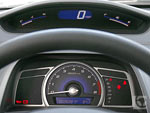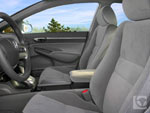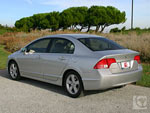 The occasional hiccup interrupts every winning streak, even one that runs as long as the Honda Civic's. Born, raised, and home-schooled through eight generations now, the hiccup was unlucky seven, the Civic born in 2001 that's fading out of showrooms now. Yes, it did its job well, but with the same underpowered engines as before, a downgraded suspension that alienated enthusiasts, a softer and slower Civic Si, and an also-ran hybrid variant, people were starting to question the Civic's competitive edge.
The occasional hiccup interrupts every winning streak, even one that runs as long as the Honda Civic's. Born, raised, and home-schooled through eight generations now, the hiccup was unlucky seven, the Civic born in 2001 that's fading out of showrooms now. Yes, it did its job well, but with the same underpowered engines as before, a downgraded suspension that alienated enthusiasts, a softer and slower Civic Si, and an also-ran hybrid variant, people were starting to question the Civic's competitive edge.That question will be asked no more. Honda put the past five years to good use, giving the latest Civic a wealth of improvements on multiple fronts that add up to a better car. It starts with the most expressive exterior to come our way since the revolutionarily rounded 1992 model, and if you think that's something, wait till you see the inside. The Si returns with the engine it deserved from the start, the Hybrid returns with more speed and fuel economy, and all other Civics enjoy a streamlined, improved powertrain lineup along with more features in the luxury, mechanical, and safety departments all at once.
Just when you thought the Civic was getting too predictable. . .
Road Test

Of course, predictability is one of the Civic's key selling points. Many customers order Civics because they know what to expect, and those who do will mostly still find it. Not long after you crank the key and shift to D, you notice the predicable tracking, a modestly-powered engine that's silk-smooth, and machinery that gives trusty outputs for any given input.
If you own an older model, you'll first notice the much more rapid response. Civics used to have a steering wheel that could be twirled around 3.6 times; that number has fallen sharply to 2.7. I found it pleasantly quick in the city, a little twitchy on the freeway. If you think faster is better and see nothing wrong with a Civic having a faster rack than an Acura NSX, Honda's got your ride.
The chassis got handling upgrades to support this. Along with a revised version of the previous strut front, double-wishbone rear suspension (sorry, tuners, the front wishbones have not returned), stabilizer bars now keep both ends of the body level in turns. Civics have been accused of being "under-tired" before, but new 16-inch wheels have boosted roadholding abilities to the point that gunning the throttle on a freeway on-ramp hardly even breaks traction, and provoking understeer takes a determined act of un-civic behavior. The ride is about the same as always - kind of stiff, maybe at the trailing end of comfortable - but outside noises seem a bit better squelched than before.
Anyone who looks closely should sense a bit of extra go-power from a new 4-cylinder engine that's still a 16-valve, SOHC, aluminum unit (chain-driven), but after inching up from 1.7 to 1.8 liters, no longer carries the smallest volume in the class. Thanks to an i-VTEC system (whose operation is no longer dependent on just RPM) that works hard to save fuel via reduced pumping losses in low-load situations and give more power up top, this little mill produces 140 horsepower - 16 more than the Corolla or Sentra's 1.8-liter - which passes for adequate pep for the majority of driving. It's a smooth operator that's completely unstressed at redline and quiet enough at idle to pass for a hybrid, and a new drive-by-wire throttle keeps its power delivery linear.
Improved numbers notwithstanding, speed can still be an issue. Passing is a gradual process, hill climbing always takes a few downshifts, and there are those moments when you excitedly think "I'm gonna floor it!" only to discover that you already did.
But even with the bigger engine, those who buy Civics to conserve have at least as much to celebrate as before, for the EPA's gas mileage numbers for a Civic EX automatic have crept up from 31/38 to 30/40. In fact, our amazing average of 33 set a record high in our ever-growing fuel economy database. Only one conventional gas-powered car could theoretically get better mileage than the Civic - the Scion xA - and this is a theory our experience does not support. Experience also proved that the Civic can break through 100 MPH on mountain stretches where the slower Scion caps out at 80. Honda claims the power of a 2.0-liter engine and the mileage of a 1.5, and that actually sounds about right.
More power and more freeway mileage? We can partially thank the new automatic transmission, the only one in the class with five forward gears (unless the Jetta counts). With a numerically higher bottom gear (2.66) helping low-end punch and a numerically lower top gear (0.53) keeping RPM down on cruises, it should take the mystery out of these seemingly contradictory improvements. Like pretty much every Civic built within the past 33 years, it still has the annoying habits of overeager downshifting (plus a lever that physically slides straight to the gas-wasting D3 slot), but it's now infrequent enough to tolerate, and the shifts are prompt.
The greatest news: these traits apply to all Civics, all to the same degree. Every year prior, the highest-volume-seller LX model got short shrift with no rear stabilizer bar, wimpy 14-or-smaller-inch tires, and a depowered non-VTEC engine that coughed up less horsepower. Now the LX (and even the bottom-rung DX) gets all the same good stuff as the EX except for rear disc brakes, which have returned for the first time since 1995.
Honda Civics are moving up, and moving together.
Inside & Out

Anyone see a little Toyota Prius influence here? What a coincidence; so do we!
You'll see more in the futuristic cockpit. Obviously, the first items to catch the eye are the instruments, which now stand divided on two sides of a horizontal strip. Note the word "horizontal," for it's the key reason why Honda's approach proves to not be the screwup it is in all those Toyotas. Instead of having to turn your head and look somewhere far off from your line of sight, you simply look up and down, as usual. Better yet, checking speed has you looking down to a lesser degree and less often - maybe not at all since the digits are big enough to read in the corner of your eyes - and the separation of speedometer and tachometer in both placement (north/south) and format (digital/analog) makes them easier to process mentally. Freaky foreigners who use the evil metric system can also switch from MPH to KPH at the press of a button. Maybe this is getting too analytical, but Honda just reinvented the dashboard for the better, so maybe it's not. On a final note, it lights up intriguingly in the dark of night.
It could've been perfect, but Honda had to spoil it with an ugly two-spoke steering wheel whose push-buttons are lined up in a row and identical in feel; it's all too easy to confuse those channel and volume adjusters. For better or worse, many drivers also took immediate notice of the wheel's shrunken diameter.
Show's over, on to the boring stuff. Seating? Still comfortable as ever, and now more accommodating. Now that they finally fixed the too-reclined seatback problem (actually, they fixed it in 2001), we long-legged drivers can actually buy a Civic now. Better yet, the Civic just became the fourth entry in this class to feature a steering wheel that adjusts for reach (following the Volkswagens, Ford's Focus, and Mazda's 3) and all models also have height adjusters. I wouldn't mind losing the daytime running lights or the door locks that imprison you automatically, and is it our bad timing with dry weather, or do the Civic's cloth seats generate a disproportionately high amount of static electricity?
Every new Civic seems to mandate dimensional increases, so the sedan's length, width, height, and wheelbase of 176.7, 68.9, 56.5, and 106.3 inches are 1.3, 1.4, 0.2, and 3.2 inches longer than last year. Passenger room barely changed at all, so the Civic still has a back seat that's best suited for two average-sized people. The seat is a little too low and reclined, but the flat floor greatly helps passengers maintain their sense of personal space in times of crowding. Everyone rides more safely this year with standard curtain air bags, active head restraints, and 3-point belts in all positions.
Front-row ergonomics are no less than great, with just enough color and imaginative shapes to keep things interesting without giving up the least bit of functionality. The Civic features big, sturdy cupholders, a big glovebox and console, useful map pockets, two power outlets, and minor cubbies and compartments all around.
Honda has undergone a radical overnight shift in its attitude about low-end audio. Before, even EX model Civics came with skimpy head units and two-digit wattage numbers, while today even the LX claims 160 watts, speed-sensitive volume control, and MP3/WMA playback capability. If that's not enough, EX models bump speaker count from four to six and add an auxiliary input jack for iPods.
Sound quality might impress. . . for the price. Despite all the wattage and welcome new features, I still wasn't ecstatic with how radio stations or my personal music collection sounded through those speakers. Also, the disc reader irritatingly skips the first half-second of every track, depriving every song of its intro beat. Personal experience with Hondas tells me that swapping out the head unit for a better one would fix everything, but that would ruin the Civic's masterfully planned dashboard. Nothing disappoints us Generation Y kids than having to settle for a factory stereo. Honda, don't you know your audience by now?
Other Thoughts

With the unloved hatchback finally dead, the remaining Civic roster looks much like before. We've still got DX, LX, EX trim lines under either the sedan or coupe body, with either the automatic or manual transmission. $4,700 spans the range between the cheapest Civic (stick DX coupe, $14,910) and the costliest (automatic EX sedan, $19,610). The journey is easy to trace: each extra door costs $100 and the automatic transmission costs $900. From DX to LX costs $1,950. From LX to EX is another $1,950 on the coupe, though only $1,750 on the sedan.
Even the DX includes power windows, antilock brakes with EBD, 15-inch wheels, telescopic steering column, side and side curtain air bags, active head restraints, and all the good hardware, but it takes the LX to get a stereo, air conditioning, 16-inch wheels, alarm, keyless entry, cruise control, power locks, and automatic driver's window. The EX tops off the range with the stereo upgrade, disc brakes, alloy wheels, moonroof, steering wheel controls, remote trunk release on the keyless entry, and the option to purchase Honda's user-friendly navigation system for $2,000, making the Civic the second car under 20 grand (after the Mazda 3) to offer one.
Another natural gas-powered GX model is in the works, but for the present, the Hybrid and Si are filling the headlines. The Civic Hybrid, which differs with its Continuously Variable Transmission (CVT), electric steering, brake assist, automatic climate control, lightweight 15-inch alloy wheels, spoiler, and PZEV emissions rating, is now less of a compromise. Still using an 8-valve 1.3-liter engine (now i-VTEC, not just VTEC) coupled to an electric motor, total combined horsepower has increased from a sluggish 93 (the engine itself now makes 93) to a more acceptable 110, making it about as speedy as recent non-EX Civics. If you believe the EPA, city/highway fuel economy on CVT models (the manual transmission is gone) also went up from 47/48 to 49/51. Its Variable Cylinder Management can now deactivate all four cylinders, and the Civic can now cruise in electric-only mode in light-load conditions under 35 MPH.
Environmentalists have their hybrid, enthusiasts have the Si. Basically, take everything you know about the Acura RSX Type S (especially the best parts, its engine and shifter), add electric steering and throttle, a limited-slip differential, a balance shaft on the engine, and knock a cool $3,920 off the price, and you have the Civic Si. With way more power than the Scion tC and better engineering than the Cobalt SS, the Civic Si is ready to rule the sport compact world once again.
All breeds of Civic enjoy Honda's new 2006 warranty, which finally matches Honda and Nissan with 3 years/36,000 miles basic, 5 years/60,000 miles on the powertrain. It's probably not too important considering the Civic's repair record, but it's nice just the same. There's no reason to doubt the Civic's continued prominent perch atop the resale value pile, either.
Last Word
The upgrades have put the Civic back in the game. I'd still pick a more interesting-driving car with a smarter transmission, but think about it: best reliability, best resale value, and best gas mileage in one stroke? When an already solid piece of transportation promises to be so extremely easy on the wallet, it's hard to give less than a wholehearted recommendation. [source : automotive.com]
Post a Comment